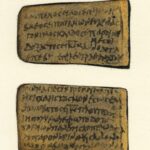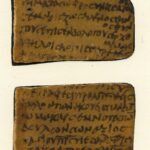| Artefact ID | 477 |
| TM ID | TM 64573 |
| Findspot (DEChriM ID) | - () | Class | Textual |
| Material | Parchment |
| Writing medium | Sheet/roll |
| Text content | Subliterary |
| Language | Greek |
| Description | P.Köln IV 172; P.Koeln IV 172 A small vellum fragment (5.2 x 4.5 cm) containing an acrostic hymn in praise of Jesus. The small format could indicate that the text was possibly used as an amulet. The ed. pr. notes that this fragment is indicative of an early form of Christian poetry, in which the metre indicates a transition from the quantifying to the accentuating system. The fragment contains two perforations in its right hand edge of the flesh-side. As the writing has been arranged in a way that avoids these perforations, it is probably that the text has been added to an already perforated sheet of parchment. This assumption is strengthened by the sequence of its content (flesh-side precedes the hair-side), all of which indicate that the sheet has been repurposed from a blank page of a codex before the writing of the hymn; see ed. pr. The right-hand margins have been demarkecated by a vertical line. The fragments contain 12-13 lines on each side, each line corresponding to a verse of the hymn. The metre is anapestic, but exhibits several violations of the quantifying measurement of the Classical metre. This format is very similar to P.Amh. I 2 (4th c. anapestic acrostic, provenance N/A). The last 4 lines contain doxology, and do not adhere to the metre or alphabet-format of the acrostic hymn. The script (majuscule) is written in a light brown ink, and is difficult to assess: its quality appears to have suffered by the small format of the parchment sheet. The text does not contain accents, breathings or other marks, but several nomina sacra occur. |
| Selection criteria | Subliterary genre (Liturgical) |
| Date from | 300 |
| Date to | 499 |
| Dating criteria | Content and format point to the first half of the 4th c. The ed. pr. compares the fragments to P.Merton II 93 (4th c., provenance N/A), but some letters are quite semblant of the 5th; see P.Berol. 5003 (an epic encomium from the late 4th/early 5th., Memnoneia). |
| Absolute/relative date | Relative date |
| Archaeological context | Unknown. |
| Accession number | Cologne, Papyrussammlung P. 3261 |


 Json data
Json data





